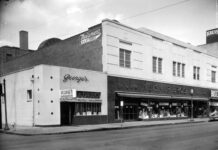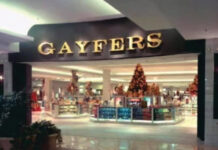
In May of 1902, a large crowd gathered in Bienville Square for the dedication of the first steel-framed structure to have been built in Mobile. One reason for the size of the gathering was the fact that President Teddy Roosevelt was the guest of honor that day.
Built as the Masonic Temple at a cost of $50,000 (equivalent to over $1.8 million today) the building stood five stories and due to the high ceilings, a reporter noted how it “towers among other buildings.” The first floor was fronted with “plate glass show windows” and became a location for Birmingham’s E. E. Forbes Piano Company which not only sold pianos and organs but also offered “type-writers, sewing machines, small musical instruments and sheet music.”
The second and third floors were rented out as offices which were equipped with both electric and gas lighting and steam heat. In the news account, there is no mention of an elevator, but the building was described as “practically fire-proof, built of slow-burning construction.” There was a 50 foot fire hose on each floor and iron fire escapes on either side of the structure.
The various lodges of the Masons had previously been meeting on the third floor of Temperance Hall which once stood on the north east corner of St. Joseph and St. Michael streets. By 1900, the membership in those lodges was rapidly growing and a larger space was needed.
Elegant Lodge Rooms and a Roof Garden
Each of the top two floors held a 35-foot by 57-foot Lodge Room, a large banquet room with a kitchen and “reception and property rooms.” The lodge rooms featured “deep cornices and beamed ceilings” which both concealed electric lights. According to the news account, “the fourth floor will be used exclusively by the blue lodges” while the fifth was used by “the Chapter of Royal Arch Masons, Council of Royal and Select Masons, Knights Templar and Scottish Rite Masons.”
Attached to the exterior was a series of globes, each of which was decorated with the emblem of one of those orders. When one of those was lit, it indicated which group was meeting there that night.
A roof top garden was included “for use by the Masons and their friends.” The facade featured “buff Bedford stone and matching terra cotta…and cartouches with Masonic emblems.” It was crowned with an ornate cornice.
The large space once occupied by the piano company was replaced by Claude Moore Jewelers and the second home of the American National Bank and Trust Company. Meanwhile, the two office floors housed an assortment of insurance agents, finance companies and even a chiropractor.
The building seems to have been successful through the late 1950s. The bank and jeweler and the various rented offices provided funds to supplement the dues paid by the Masonic orders. Change was coming, however.
City directories indicate that by the 1960s, the bank had built a new home and Claude Moore had moved out to Springdale Plaza. In 1968, the first two floors were vacant while the third housed a charm school and the 20th Century College. The Masonic orders were using only the fourth. A year later, the entire building was listed as being vacant.
A Sad Ending for the Masonic Temple
A photo taken some time later shows the once proud structure looking derelict. The arched stone entrance and balcony are gone. A standard commercial facade covers the ground floor. Rising above are smashed windows and the once ornate cornice has been removed.
By the 1990s, the owners had sealed up the broken windows out front, but images reflect numerous open or missing windows on the sides leading to further deterioration. In 1997, the owners were approached with an offer which would have resulted in a parking lot and instead they donated it to the city.
The Mobile Historic Development Commission actively marketed the building with Historic Preservation Tax Incentives, but there were no takers. Meanwhile, in 1998, Hurricane Georges only made the interior worse.
Two years later, Mayor Mike Dow asked the Mobile City Council for $50,000 for “stabilization and weatherization” for the former Temple. The councilors balked, refusing to spend money on “a building nobody wants.”
A fire destroyed what was left of this once remarkable landmark leaving only the facade. New construction has since replaced it.





